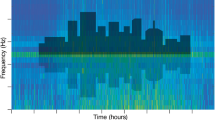Abstract
European Directive 2002/49/EC indicates that member states must provide mappings of noise levels throughout all areas with more than 250,000 inhabitants and for all major roads with a traffic volume exceeding six million vehicles per year. Noise levels in regions containing major railways and airports should be mapped as well. Traditionally, noise mappings have been created using sound level meters, and the noise indicator used is the equivalent continuous sound pressure level. However, over the last few years, Wireless Sensor Networks have been proposed for this task, but little attention has been paid to the deployment of frequency-based algorithms adapted to resource-constrained devices to calculate the noise indicator. This work presents a new algorithm based on frequency domain, which has been implemented successfully in a resource-constrained device for calculating the noise indicator. Several experiments have been carried-out using a variety of scenarios to compare the differences between the noise indicators calculated by the sensor and those from a commercial sound level meter. The results show the effectiveness of the algorithm because the difference between our method and the traditional technique is less than 2 % (1.2 dBA). This comparison pertains to an urban area, and it demonstrates that the proposed approach can be used for noise mappings in real time and space.








Similar content being viewed by others
References
European Commission. Green Paper on Future Noise Policy. Com (96) 540 final, November 1996
Directive 2002/49/EC of the European Parliament and of the Council of 25 June 2002 relating to the Assessment and Management of Environmental Noise. Official Journal of the European Communities, July 2002
European Commission Working Group Assessment of Exposure to Noise. Good Practice Guide for Strategic Noise Mapping and the Production of Associated Data on Noise Exposure, January 2006
Santini S, Ostermaier B, Vitaletti A (2008) First Experiences Using Wireless Sensor Networks for Noise Pollution Monitoring. Proc. Workshop on Real-World Wireless Sensor, Networks, pp 61–65
Bhusari P, Asutkar GM and Tech M (2013) Design of Noise Pollution Monitoring System Using Wireless Sensor Network. International Journal of Software and Web Sciences (IJSWS), pp. 55–58.
Gubbi J, Marusic S, Law Y, Rao A.S. and Palaniswami (2013) A Pilot Study of Urban Noise Monitoring Architecture using Wireless Sensor Networks. International Conference on Advances in Computing, Communications and Informatics (ICACCI), August
Santini S, Ostermaier B and Adelmann R (2009) On the use of sensor nodes and mobile phones for the assessment of noise pollution levels in urban environments. Proc. 6th International Conference on Networked Sensing Systems, pp 1–8.
Santini S, Vitaletti A (2007) Wireless Sensor Networks for Noise pollution Monitoring. 6 GI/ITG KuVS Fachgespraech Drahtlose Sensornetze Aachen, Germany, 16–17(July 2007)
Filipponi L, Santini S, Vitaletti A. (2008) Data Collection in Wireless Sensor Networks for Noise Pollution Monitoring. Proceedings of the 4th IEEE International Conference on Distributed Computing in Sensor Systems (DCOSS ’08), pp. 492–497.
ISO Standard 1999:1990. Acoustics − Determination of occupational noise exposure and estimation of noise-induced hearing impairment.
Kumar-Rana R, Tung-Chou C, Kanhere S, Bulusu N, Hu W (2010) Ear-Phone: An End-to-End Participatory Urban Noise Mapping System. Proc. 9th ACM/IEEE International Conference on Information Processing in Sensor Networks (IPSN’10) pp 105–116. doi: 10.1145/1791212.1791226
Karl H, Willig A (2007) Protocols and Architectures for Wireless Sensor Networks. John Wiley & Sons, Chichester
Moteiv Corporation (2013). http://www.sentilla.com (accessed on November 2013)
Santini A (2009) TinyLAB: A Matlab-Based Framework for Interaction with Wireless Sensor Networks. The First European TinyOS Technology Exchange (ETTX 2009), Cork
Standard IEC651 Type 2 SLM.
Normative IEC 61672:2003.
Bacon D, Graham S, Sharp O (1994) Compiler Transformations for High-Performance Computing. ACM Computing Surveys, Vol 26, Nº 4.
Muchnick S (1997) Avanced Compiler Design Impementation. Morgan Kaufmann, San Diego
PCE-353 Sound Level Meter (2013). http://www.industrial-needs.com/technical-data/datalogging-leq-sound-level-meter.htm (accessed on November 2013)
Sun SPOT (2013) https://www.sunspotworld.com/ (accessed on November 2013)
ADT7411 (2013) http://www.analog.com/static/imported-files/data_sheets/ADT7411.pdf (accessed on 30 November 2013)
Acknowledgments
This work was supported by the Centro de Estudios Avanzados en Tecnologias de la Información y Comunicación – University of Jaen (Project CEATIC-2013-001).
Author information
Authors and Affiliations
Corresponding author
Rights and permissions
About this article
Cite this article
Mariscal-Ramirez, J.A., Fernandez-Prieto, J.A., Canada-Bago, J. et al. A new algorithm to monitor noise pollution adapted to resource-constrained devices. Multimed Tools Appl 74, 9175–9189 (2015). https://doi.org/10.1007/s11042-014-2074-3
Received:
Revised:
Accepted:
Published:
Issue Date:
DOI: https://doi.org/10.1007/s11042-014-2074-3




